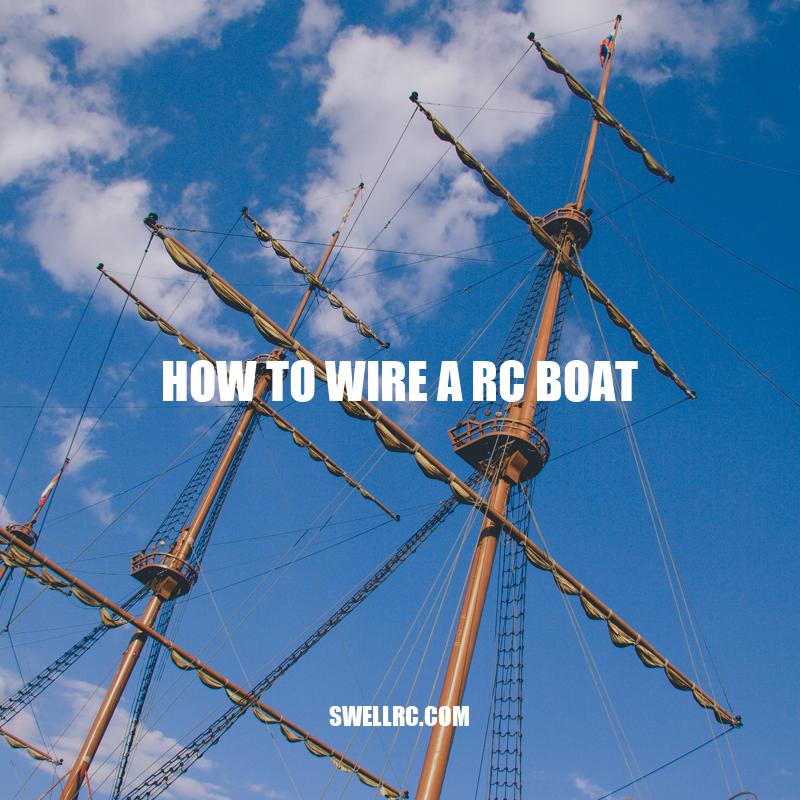Mastering RC Boat Wiring: A Step-by-Step Guide
Wiring is an essential component of an RC boat that connects all the electrical parts of the boat. It is not only responsible for powering all the systems but also ensures the smooth functioning of the RC boat. Wiring is not just about connecting the various electrical components, but it is a process that requires planning, knowledge, and skill to be executed effectively. Improper wiring can not only lead to poor performance but can also damage the boat or in some cases, cause accidents. Therefore, it is crucial to have a clear plan while wiring an RC boat and to use high-quality materials to ensure safe and smooth operation. In this article, we will explain the step-by-step process of wiring an RC boat, from gathering materials to testing the wiring. Whether you are wiring your RC boat for the first time or looking for tips to improve your wiring skills, this guide will provide you with the essential knowledge you need to get started.
Gather Materials
Before wiring an RC boat, it’s important to gather all the necessary materials to avoid delays and ensure efficiency. Here are the materials you will need:
- Electrical wire (insulated) appropriate for your RC boat’s voltage and amperage requirements
- A soldering iron and solder
- Heat-shrink tubing to cover any exposed wire
- A wire stripper
- Connectors such as bullet connectors, banana plugs, and XT60 connectors
- A battery holder for your RC boat battery
- Heat gun or lighter to shrink the heat-shrink tubing
You can purchase these materials at local hobby shops, online stores that specialize in RC equipment, or online marketplaces such as Amazon, eBay, or Banggood. It’s important to use high-quality materials to ensure the safety and performance of your RC boat. Some of the best websites to buy RC boat wiring materials include Horizon Hobby, HobbyKing, and Tower Hobbies.
What material is used for RC boats?
RC boats are made of various materials, depending on their purpose and budget. Here are the most common materials used for RC boats:
- Plastic: Cheap and lightweight, plastic is the go-to material for beginner RC boats. However, it’s not very durable and may crack or warp over time.
- Fiberglass: Fiberglass is a popular choice for high-performance RC boats that need to be lightweight and strong. It’s more expensive than plastic but more durable.
- Wood: Wood is a classic material for RC boat construction, especially for scale models. It’s easy to work with, and gives a classic look to the boat.
- Metal: Metal hulls are heavy but sturdy, making them ideal for large RC boats that need to be resistant to impact and waves.
For more information on RC boat materials, check out RC Boat Guide (rcboatguide.com).
Plan the Wiring
Before starting the actual wiring process, it’s important to have a plan to avoid confusion and ensure everything is done correctly. Here are the steps to plan your RC boat’s wiring:
- Draw a diagram of where each component will be placed in your RC boat.
- Determine the appropriate length of wire that will be needed for each connection.
- Choose the appropriate connectors for each connection.
- Label the connections and their corresponding wire colors to avoid confusion.
- Ensure that the wiring is neat and tidy to avoid tangling and difficulty with maintenance.
Did you know that the proper wiring can improve the performance of your RC boat? A well-designed wiring system can help distribute power more efficiently, resulting in better performance and longer battery life. In addition, properly planned wiring can help you diagnose and fix any problems that may arise.
For those who are not confident in creating a wiring plan, there are some pre-made wiring harnesses available for purchase. These can be found on websites such as Amazon, HobbyKing, and Banggood. It’s important to choose a wiring harness that is compatible with your RC boat’s make and model.
Here’s an example of a simple wiring diagram for an RC boat:
| Component | Wire Color | Connection |
|---|---|---|
| Battery | Red | Connect to positive terminal of motor |
| Battery | Black | Connect to negative terminal of motor |
| ESC | Yellow | Connect to signal wire on receiver |
| ESC | Red | Connect to positive terminal of battery |
| ESC | Black | Connect to negative terminal of battery |
| Receiver | Red | Connect to positive terminal of battery |
| Receiver | Black | Connect to negative terminal of battery |
How do you make a wiring plan?
To make a wiring plan, follow these steps:
- Identify the purpose of the wiring plan
- Sketch the project area and include all relevant electrical components
- Mark the locations and types of outlets, switches, and fixtures
- Select the appropriate electrical symbols and make a legend
- Create a wiring diagram that shows the connections between the components
There are several software options available that can assist in creating a wiring plan, such as SmartDraw and Edraw. These programs offer pre-made templates and symbols, making it easy to create a professional-looking wiring plan in no time.
Strip the Wires
Once the wiring plan is complete, it’s time to prepare the wires for soldering. Here are some steps to help strip the wires correctly:
- Use wire strippers to strip the ends of each wire.
- Remove only the amount of insulation needed to make the connection.
- Trim any frayed or damaged wires to avoid poor connections.
- Twist the exposed wires together to make them easier to solder.
It’s important to strip the wires carefully to avoid damaging the wire or exposing too much of the bare wire. Using a high-quality wire stripper can make the process smoother and more precise.
Once the wires are stripped, you may also want to use a multimeter to ensure that each wire has continuity and is not broken. This can help you identify any problems before the soldering process begins.
For those who are not confident in stripping wires, pre-cut wire sets are available for purchase. These can be found on websites such as Amazon, HobbyKing, and Banggood. Be sure to check that the wire set is compatible with your RC boat’s make and model.
In the next paragraph, we will discuss how to solder the wires together to create a solid connection.
How Do You Strip Wire Effectively?
To strip wire effectively, follow these steps:
- Choose the right type of wire stripper for the job.
- Insert the wire into the correct sized stripping slot.
- Squeeze the handles of the wire stripper to cut through the insulation.
- Twist the wire stripper around the wire to remove the insulation.
- Inspect the wire to ensure all insulation is removed.
For more information and to purchase wire strippers, visit websites like Amazon or Home Depot.
Solder the Wires
Soldering is an essential process for creating a secure and durable connection between wires. Here are some steps to help with soldering:
- Use a soldering iron to heat the wire and create a pool of melted solder.
- Feed the wire into the pool of melted solder.
- Continue heating the wire for a few seconds until the solder is firm.
- Remove the soldering iron and allow the solder to cool and harden.
It’s important to ensure that the solder penetrates into the wire strands to create a strong connection.
When soldering, it’s essential to use safety precautions to avoid burns and injuries. Always wear protective gloves and safety glasses when soldering.
For those who are not confident in soldering, there are pre-soldered wire sets available for purchase. These can be found on websites such as Amazon, eBay, and AliExpress. However, it’s important to ensure that the pre-soldered wires are compatible with your RC boat’s make and model.
In the next section, we will cover how to connect the wires using various connectors.
How do you solder for beginners?
Here are a few steps to get you started with soldering:
- Choose the right soldering iron: Look for a soldering iron that is easy to handle and has adjustable temperature settings.
- Prepare your workspace: Make sure your workspace is clean, well-ventilated and free from any flammable materials.
- Gather your materials: You will need solder, flux, and a soldering iron stand.
- Practice proper technique: Ensure that the tip of the iron is clean and tinned, hold the iron at the correct angle, and apply heat to the joint to melt the solder into place.
There are many resources available online to help beginners learn how to solder, including instructional videos and articles. Websites like Instructables and Sparkfun offer step-by-step tutorials and tips to help you get started. Additionally, purchasing a beginner’s soldering kit, such as the Aoyue Variable Soldering Station, can provide you with all the necessary tools to start soldering right away.
Connect the Wires with Connectors
After soldering the wires, the next step is to connect them using connectors. Here are some steps to help with connecting wires using connectors:
- Choose the appropriate connector for your wires based on their sizes and types.
- Crimp the connector onto the wire and ensure it is secure.
- Insert the connector into the RC boat’s receiver or motor as needed.
- Secure the connectors using cable ties or heat shrink tubing to prevent them from coming loose.
It’s important to take your time and ensure that the connectors are connected and secured correctly to avoid issues with the RC boat’s performance. Further tips include:
- Double-check that the wire is correctly stripped of insulation before crimping the connectors.
- Use only quality connectors to avoid poor connections that can lead to electrical issues.
- Check the manufacturer’s instructions for proper connector use and assembly.
There are various connectors available for purchase for RC boats, including banana plugs, XT60 connectors, and bullet connectors. Websites such as HobbyKing, Banggood, and Tower Hobbies offer a wide range of connectors to choose from.
Once the wiring process is complete, it’s crucial to test the RC boat to ensure everything is functioning correctly. We will discuss testing in the following section.
How do you solder RC car battery connectors?
To solder RC car battery connectors, follow these steps:
- Strip the wires of the battery connector and the power cable to 1/4 inch.
- Apply flux to the stripped ends of the wires.
- Insert the wires halfway into the connector, one wire in each hole.
- Heat the joint with a soldering iron, and apply a small amount of solder to the joint.
- Remove the heat and let the solder cool for a few seconds.
- Tug on the wires to ensure a solid connection. If it comes off easily, reheat and add more solder.
Remember to always take safety precautions when handling a soldering iron. Wear safety goggles and work in a well-ventilated area.
For more information on RC car maintenance and repairs, check out websites such as RC Planet, HobbyKing, and Tower Hobbies. They offer a wide range of products and resources for hobbyists and professionals alike.
Testing the RC Boat Wiring
After completing the wiring process, it’s important to test the RC boat to ensure that everything is functioning correctly. Here are some steps to test the boat’s wiring:
- Turn on the transmitter and RC boat.
- Ensure that the boat’s motor moves when the throttle is pushed or that the servo motors move when the controls are moved.
- Check that the steering servo is operating correctly.
- Check the LED lights and ensure they are bright and consistently functioning, if installed.
Testing the RC boat before using it can help prevent potentially dangerous situations that can occur if the wiring is not done correctly. If an issue occurs while testing, it’s vital to double-check the wiring and troubleshoot the problem before using the boat.
If you’re having difficulty in testing your RC boat or need more information, various online forums or RC hobby websites can provide useful information. Websites like RC Groups, RC Universe, and RCboatguide.com offer forums where hobbyists can discuss various RC boat topics, including wiring and testing. Additionally, some online stores selling RC boats and parts have customer support or technical teams that can provide help and advice on various issues.
Conclusion
Wiring an RC boat can be a daunting task, but by following the steps outlined in this article, you should be able to do it yourself. Remember, the key to successful wiring is planning, precision, and patience. Take your time, use the right tools and materials, and follow the correct wiring diagram to ensure that everything is connected correctly.
Keep in mind that safety is paramount when dealing with electricity, so always wear protective gear and ensure that all the connections are well insulated. Testing your RC boat before using it will give you peace of mind that everything is functioning correctly.
By following best practices and the proper techniques, you can have a well-wired RC boat that performs exceptionally. Don’t forget to consult online forums, RC hobby websites, and customer support teams for additional help and advice.
In conclusion, wiring an RC boat is an essential skill for any RC hobbyist to possess. If you’re new to the process, it may take some time and effort to get it right, but with practice, you’ll get better and more confident. Enjoy your newly wired RC boat!



